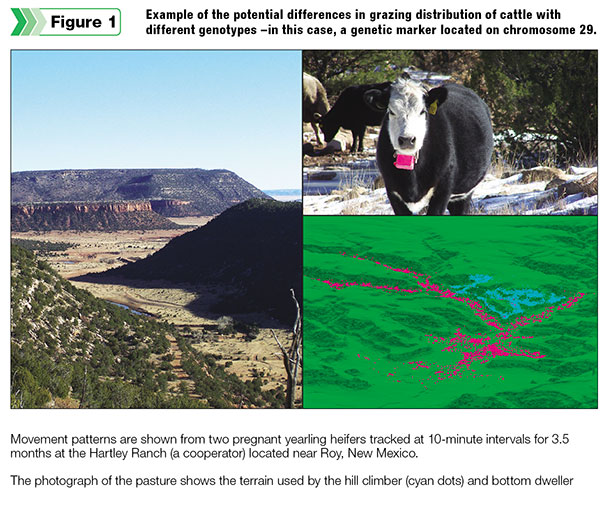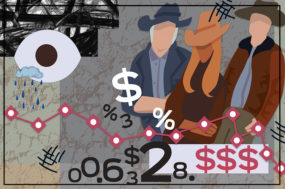In the western U.S., ranchers utilize extensive and rugged rangeland pastures. Generally, cattle are reluctant to graze steep slopes, climb high ridges and travel long distances from water.
These preferences often lead to greater forage use on gentle terrain located near water, including riparian areas, while forage on rugged terrain and areas far from water are usually left ungrazed.
Most problems associated with livestock grazing, especially on public lands, are the result of undesirable distribution rather than stocking rate.
In other words, concerns with cattle grazing are usually not a result of too many cows but rather cattle grazing too much in one area and not enough in another.
Traditional approaches to improve cattle grazing distribution rely on capital expenditures such as water developments and fencing that are expensive, require regular maintenance and in some cases may not be practical.
As an alternative, managers may be able to use tools to change animal behavior rather than adding water or fences. Selection for grazing distribution has the potential to change cattle grazing patterns.
Creating hill-climbing herds
In a study we conducted in Montana a few years ago, cattle that previously showed a preference for steep slopes, high terrain and areas far from water (hill climbers) spent less time grazing in riparian areas and more time in rugged terrain than cattle previously observed on gentle slopes near water (bottom dwellers).
Stubble heights in riparian areas in pastures grazed by hill climbers exceeded the typical public land standard of 4 to 5 inches, while riparian stubble heights in pastures grazed by bottom dwellers did not.
This demonstrates that if selection were used to create herds with primarily hill-climber cows, they would use rough terrain more uniformly and graze riparian areas less intensively than herds made up of bottom-dweller cows.
A recently completed research project funded by the USDA Western SARE program and conducted by graduate students Adrienne Lipka, Steven Lunt, Mitch Stephenson and co-investigators – Milt Thomas of Colorado State University; Juan Medrano, Angela Canovas and Gonzalo Rincon of University of California – Davis; and Delyn Jensen of Montana State University – showed that cattle grazing distribution is affected by both nature and nurture.
Understanding the degree that nature and nurture affect a trait is important because if nature is important, we can use bull selection; if only nurture is important, selection must rely on culling cows.
In this study, we tracked cattle with GPS collars at seven ranches located in three states (New Mexico, Arizona and Montana). We identified several genetic markers (single-nucleotide polymorphisms, or SNP) closely associated with cattle grazing distribution.
 For example, the two heifers in Figure 1 have different genotypes for a marker on chromosome 29. One heifer spent most of her time on gentle terrain of the valley bottom, while the other usually used steep slopes along the surrounding canyon wall.
For example, the two heifers in Figure 1 have different genotypes for a marker on chromosome 29. One heifer spent most of her time on gentle terrain of the valley bottom, while the other usually used steep slopes along the surrounding canyon wall.
Using statistical analyses, we were able to estimate how much variability was accounted for by the genetic markers in cattle grazing steep slopes, high elevations and areas far from water.
A single genetic marker accounted for up to 24 percent of the variation in terrain use, and the combination of relevant genetic markers accounted for up to 36 percent of the variation.
The remaining variation is associated primarily with environmental factors such as learning and experience.
Tracing DNA in the terrain
These results suggest that heritability of grazing distribution in cattle may be similar to weaning weight. Cattlemen have selected for weaning weight over the last 30 years and have made significant progress.
The most exciting part of this research is that relatively inexpensive DNA tests based on blood samples could potentially be used to determine if a bull would likely sire daughters that were hill climbers or bottom dwellers.
Rather than needing to track cows and bulls, ranchers could simply collect a blood sample, send it for a DNA test and have the test results processed to calculate molecular breeding values that could be used, like estimated progeny differences (EPDs), to rank bulls (and cows) for their genetic potential to improve grazing distribution.
However, we must caution that this research should be considered preliminary because it was based on data from 158 cows. Most genetic studies use at least 500 animals.
Unlike traits such as weight gain, grazing distribution is difficult and expensive to measure. Fortunately, the USDA Western SARE program has provided additional funding to validate our previous results and develop molecular breeding values and selection tools so ranchers using rugged and extensive rangelands can select beef cattle for grazing distribution.
Cattle grazing distribution is also affected by early learning and experience. Milt Thomas, graduate student Barbara Witmore, colleagues from Texas A&M University (John Walker and Doug Tolleson) and I conducted a study at the New Mexico State University Chihuahuan Desert Rangeland Research Center (CDRRC) near Las Cruces, New Mexico, where we compared the grazing behavior of Brangus cows with differing experiences.
One group of cows was born, raised and remained in the desert at the CDRRC (native cows). Another group was born and raised at a ranch in east Texas and then moved to the CDRRC (naive cows).
The third group was born and raised in the desert at the CDRRC and then transported to the east Texas ranch for three years before being returned to the CDRRC (tourist cows).
Like many ranches, we moved a portion of cattle during a drought period and then brought part of them back three years later and used them in the study. The CDRRC and the Texas ranch both used Brangus cattle with similar breeding, but the environments differed.
The Texas ranch usually receives about 40 inches of annual precipitation and grazes small bermudagrass pastures, while CDRRC receives about 9 inches of precipitation and grazes extensive pastures comprised of grasses and shrubs.
We kept the groups separate and evaluated them in large pastures (3,000-plus acres) during three periods:
- Winter when it was cool, forage was dormant and low-quality, and cows were pregnant and dry
- Early summer before our monsoon season when it was hot, forage quality was low and cows had 2- to 3-month-old calves and were lactating
- Late summer (our monsoon period) when temperatures were warm, forage quality was outstanding because of above-normal precipitation and cows were lactating
 In all periods, native cows used areas farther from water than both naive and tourist cows (Table 1).
In all periods, native cows used areas farther from water than both naive and tourist cows (Table 1).
During winter and early summer when forage quality was low, calves born at the CDRRC (native and tourist groups) selected diets that contained more protein than naive cows, but when forage quality was high during the monsoon, all groups selected a diet that exceeded requirements, but the naive cows selected better-quality diets.
Naive cows did not appear to graze shrubs, which likely helped improve diet quality of native and tourist cows when grasses were dormant. When grass quality was high (similar to Texas), they selected better diets than native and tourist cows that probably still consumed some shrubs.
Conclusions
This study highlights the importance of selecting female replacements from your ranch. Heifers raised on your ranch are adapted to local environmental conditions and have learned what plants to eat and where to forage.
If female replacements must be purchased, try to buy heifers from environments similar to your ranch. In addition, it is important to make timely adjustments in stocking rate during drought to ensure you can maintain a core group of cows that have the genetics and experience to thrive in your conditions.
Adapted cows can pass favorable genes to future generations and also can help replacement females learn to graze local forages and successfully navigate within the pastures.







